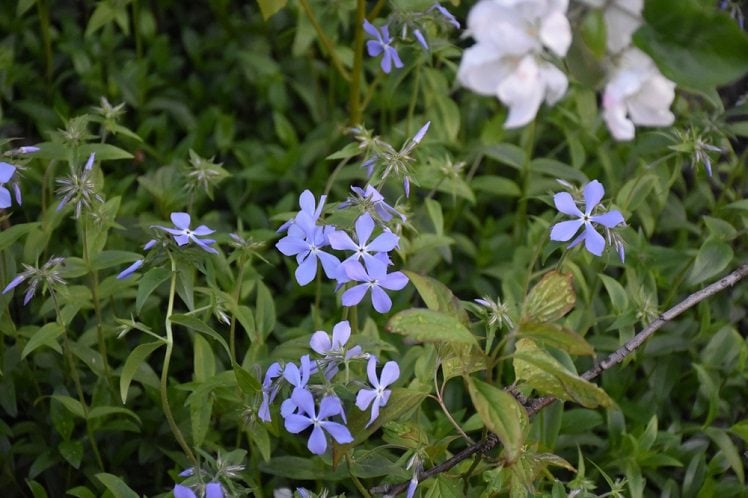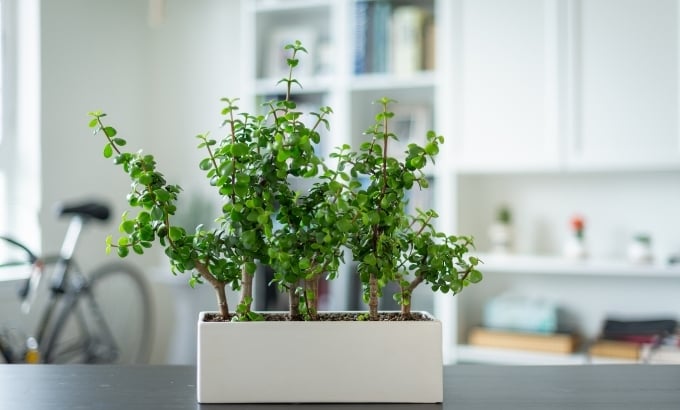North Carolina is a state in North America with numerous beautiful and unique native plants. It is home to various native grasses, shrubs, trees, and perennials that are amazing for landscaping.
Compared to non-native plants, native plants are preferred by many as the best landscaping plants in North Carolina since they have more varieties and excellent features, and are low maintenance.
Most of them are flowering, while some even are fruit-bearing plants. And for that reason, we have prepared a list of the best landscaping plants for North Carolina and a quick guide for growing those tremendous native plants. Let’s check them out!
Table of Contents
- BEST Landscaping Plants for North Carolina
- 1. Aromatic Aster (Symphyotrichum Oblongifolium)
- 2. Black-Eyed Susan (Rudbeckia Hirta)
- 3. Blue Phlox (Phlox Divaricata)
- 4. Eastern Wild Columbine (Aquilegia Canadensis)
- 5. Flame Azalea (Rhododendron Calendulaceum)
- 6. Flowering Dogwood (Cornus Florida)
- 7. Great White Trillium (Trillium Grandiflorum)
- 8. Green and Gold (Chrysogonum Virginianum)
- 9. Heartleaf Foamflower (Tiarella Cordifolia)
- 10. Tall White Beardtongue (Penstemon Digitalis)
- 11. Virginia Bluebells (Mertensia Virginica)
- Final Thought
- FAQ (Frequently Asked Questions)
BEST Landscaping Plants for North Carolina
If you’re tired of scouring endless plant catalogs, only to end up with a garden as lively as a cardboard box, then you’re in for a treat! North Carolina isn’t just about BBQ and basketball; it’s a horticultural paradise waiting to explode into color right in your backyard. Our focus today is on plants that not only turn heads but also embrace North Carolina’s unique climate like a long-lost friend.
So buckle up, green thumbs and garden novices alike, as we unearth the top landscaping plants that’ll make your North Carolina garden the talk of the neighborhood.
1. Aromatic Aster (Symphyotrichum Oblongifolium)


Symphyotrichum oblongifolium or Aromatic Aster is a perfect bushy flower bed if you wish to have one. This clump-forming perennial will pamper you with exquisite purple daisy-like flowers, creating a breathtaking view of any garden it grows.
Because of its beauty, Aromatic Aster attracts butterflies, bees, and moths to visit. Since it belongs to the mint family, the crushed flowers and foliage emit balsamic scents.
Moreover, growing Aromatic Aster is relatively easy. It is one of the low-maintenance perennials that thrive in full sun and dry soil, though it tolerates moist soil as long as it is well-drained. Considering its habitat, Aromatic Aster will be greatly grown in rock gardens.
2. Black-Eyed Susan (Rudbeckia Hirta)


Rudbeckia hirta or Black-Eyed Susan looks similar to sunflowers since it belongs to the same Asteraceae family with bright yellow flowers and dark brown centers. It grows 2-4 feet tall and has a long blooming period. Therefore, it will make an appealing landscape for North Carolina.
Compared to other sunflower varieties, Black-Eyed Susan is a short-lived perennial. Despite loving the sun, it will bloom longer in afternoon shade. It also loves well-drained, dry to moist, and acidic soil.
In addition, this drought-tolerant plant attracts birds and butterflies to have frequent visits. Suppose you want to cultivate this native perennial; cut off the seed head after a dry fall day to have the seeds.
3. Blue Phlox (Phlox Divaricata)


Phlox divaricata or Blue Phlox is among the best native plants showing its most exquisite spring beauty. As the name implies, this plant blooms with star-shaped blue flowers that grow vines, creating a splendid perennial landscape. This deciduous native North Carolina perennial also has evergreen foliage that will offer you endless greenery despite seasons.
Besides being beautiful, Blue Phlox is a hardy plant that thrives in partial shade and shade on rich, moist, acidic, and alkaline soils. Since it prefers humid growing conditions, medium watering is key to maintaining soil moisture.
Although pruning is not necessarily needed, you can still do it once in a while, especially after spring flowering, to spruce up the blooms.
4. Eastern Wild Columbine (Aquilegia Canadensis)


The stunning red flowers with a touch of yellow shade are the hallmarks of Aquilegia canadensis or Eastern Wild Columbine. Those combinations create a striking color contrast to the plant’s appeal. Additionally, the gracefully growing branches that carry one flower bud make it look beautiful when planted in hanging pots to decorate your patio.
Since it thrives best in the shade, Eastern Wild Columbine cannot tolerate full sun because it can scorch the blue-green leaves and stunt them.
Moreover, the plant belongs to the drought-tolerant plants; thus, it only needs low to medium watering. And slightly different from some native plants of Georgia, it prefers alkaline soils than acidic to neutral.
5. Flame Azalea (Rhododendron Calendulaceum)


You can easily recognize Rhododendron calendulaceum or Flame Azalea by its vibrant orange tubular flowers with emerging red stamens from the center, looking like a bursting flame where the native shrub gets its name. They grow earlier from the leaves or sometimes appear together. The summer green foliage will turn reddish yellow when fall comes.
To grow the best blooms of Flame Azalea, you must provide moist, acidic, well-drained soils. Nonetheless, it tolerates drought since its natural habitat is dry, rocky mountain woods.
Furthermore, this flowering native shrub to North Carolina needs a few hours of sun exposure despite loving partial shade. And to have dense, beautiful flowers of Flame Azalea, careful pruning is recommended on the young plant.
6. Flowering Dogwood (Cornus Florida)


While other native plants grow as enchanting native flowering perennials or native shrubs, Cornus Florida or Flowering Dogwood is one of the most beautiful flowering native trees for landscaping in North Carolina.
Depending on its cultivar, it features stunning pink or white blossoms that fill the stems in spring to early summer. Other than the flowers, the foliage changes into reddish-purple in the autumn, making Flowering Dogwood a favorite native tree to grow.
Suppose you are interested in growing this shade-loving tree. In that case, you can prepare a space whose soils are rich, well-drained, and acidic. It also does not need much watering, making the native tree easier to care for.
Moreover, the aromatic bark and root of flowering dogwood are natural remedies against malaria used by native Americans. Knowing it has some beneficial advantages, it is no doubt that this flower is popular among native plants lovers.
7. Great White Trillium (Trillium Grandiflorum)


Anyone who looks at this native plant will surely be captivated by its stunning stretch of white flowers with green leaves owned by Great White Trillium. This clump-forming perennial shows its most beautiful blooms in spring.
The white shade turns pale pink as it ages, which doesn’t detract from its elegance. Thanks to these excellent features, Great White Trillium will be a great choice to add to the North Carolina landscape. As a native plant, Great White Trillium requires little to no maintenance. It grows well in partial to full shade in humus-rich, moist, and well-drained soils with acid to neutral pH.
In addition, mulching with leaves in fall is necessary to obtain proper soil acidity for the plant to perform best. Furthermore, the best time to plant a lovely Great White Trillium is late summer or early fall.
8. Green and Gold (Chrysogonum Virginianum)


Talking about the best landscaping plants for North Carolina, it feels incomplete if you don’t include Green and Gold in this category.
This low-maintenance native plant bears star-shaped yellow flowers that stunningly bloom from late spring to fall. The green foliage provides a splendid combination of light colors, accentuating the flowers even more. Furthermore, this hardy native plant is tolerant to various conditions, like heat, flood, drought, and cold.
However, the Green and Gold plant needs a location with partial shade, average moist and acidic soils to have plants that grow healthy. Since it is a low-growing perennial, it is excellent as a ground cover that will perfectly decorate your landscape.
9. Heartleaf Foamflower (Tiarella Cordifolia)


Tiarella cordifolia or Heartleaf Foamflower is a clump-forming perennial herb that produces pink-tipped flower buds on top of star-shaped white blooms erect exquisitely beautiful from between the leaves.
The heart-shaped foliages are initially green with burgundy veins in the spring and fall, then turn reddish-bronze in the winter. Thanks to these wonderful qualities, Heartleaf Foamflower received a special award from the Royal Horticultural Society.
Similar to other common native plants, it requires little to no maintenance. Heartleaf Foamflower tolerates a wide range of soil pH, from acidic to alkaline. Furthermore, it withstands various types of soils as long as it is well-drained. Additionally, this ground cover loves partial sun to shade light conditions and requires only average water requirements.
10. Tall White Beardtongue (Penstemon Digitalis)


Perhaps, Penstemon digitalis is something you are looking for landscaping as it is both beautiful and low-maintenance. This native plant features bell-shaped white flowers with a touch of purple, creating an impressive mix of colors. Its erect stems carry pairs of blooms, making it a lovely plant for either natural landscape or perennial borders in the summer.
Speaking about the planting conditions, it is a drought-tolerant plant that loves full sun exposure and tolerates any soil type. Basically, it quickly adapts to the North Carolina climate and geographic areas.
Nonetheless, the root is susceptible to rot if exposed to wet soil. Moreover, Tall White Beardtongue is generally free of pest problems – another quality worth noting as one of the best landscaping plants for North Carolina.
11. Virginia Bluebells (Mertensia Virginica)


The closing species for our fantastic list of the best landscaping plants for North Carolina is Mertensia virginica or Virginia Bluebells. It features beautiful blue, bell-shaped flowers with nodding clusters of pink buds that stunningly bloom in mid-spring.
Interestingly, the blooms emit delicate sweet scents that captivate long-tongued bees, butterflies, and other pollinators. Unfortunately, it is threatened in its natural habitat due to destruction and natural disasters. It is good to know some of the requirements in planting Virginia Bluebells, especially for those interested in cultivating this endangered species. It loves rich and moist soils.
Hence, frequent watering is possible. This flowering native plant also prefers part shade to shade than the full sun because it will wilt. In addition, the Virginia Bluebells plant is best grown around shrubs or trees.
Final Thought
Landscaping in North Carolina isn’t just about planting; it’s an art, a celebration of the region’s rich horticultural tapestry. The plants we’ve discussed not only thrive in our state’s diverse climate but also paint a vibrant canvas that lasts year-round.
So, whether you’re a seasoned gardener or just starting, remember that every plant tells a story, and your garden is the novel. Don’t be shy—dive into the world of Carolina flora and let your garden sing its own unique song. Here’s to lush landscapes and happy planting!
Latest Posts:
- The Touch-Me-Not Plant: Shy on the Outside, Powerful on the Inside
- Who Knew Crushed Eggshells Could Guard Your Plants?
- My Secret DIY Weed Spray That Actually Works—No Harsh Chemicals Needed!
- Who Needs Sleeping Pills When You Have Jasmine? This Fragrant Beauty Calms Your Nerves!
- Tired of Overpriced Blueberries? Grow Your Own Endless Supply with This Simple Method!
FAQ (Frequently Asked Questions)
What bushes are good for landscaping in North Carolina?
Taken from our list, there are two shrubs or bushes that will be excellent for landscaping in North Carolina. They are Flame Azalea (Rhododendron calendulaceum) and Virginia Bluebells (Mertensia virginica).
Flame Azalea is known for its vibrant orange tubular flowers with emerging red stamens from the center, looking like a bursting flame where the native shrub gets its name. Meanwhile, Virginia Bluebells features beautiful blue, bell-shaped flowers with nodding clusters of pink buds that stunningly bloom in mid-spring.
What flowers bloom all summer in North Carolina?
Based on our list, Black-Eyed Susan (Rudbeckia fulgida) is one of the flowering native plants whose flowers bloom all summer in North Carolina. They will show off their most beautiful blooms from June to September.








